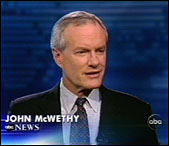Dispatch
From John McWethy
National Security Correspondent, ABC News
 |
Watch
the Video of Ted Koppel
and John McWethy discussing his
recent video shoot in Afghanistan.


|
John
McWethy reported from Afghanistan on an American special forces mission
to search caves in Tora Bora, looking for intelligence on Osama Bin
Laden's Al Qaeda network. He shot his own video for ABC News because
each network was allowed only one person on the assignment. Here are
his comments on shooting one-man-band small format digital video.
The Digital Journalist: Why did you shoot your own video with
a mini-dv camera with the special forces in Tora Bora, and how did
shooting one-man-band differ from your normal role on a network tv
team?
John McWethy: Pentagon ground rules were: One person gets to
go. That means no producer, no cameraman, no sound man. It obviously
changed entirely my routine as correspondent which is to let the cameraman
go off and do his thing while I try to talk to people off on the side
and gather information. Did it drastically hurt my ability to report?
No, but that was because I had plenty of time.
TDJ: What did you miss most about working with a beta crew?
JM: They are smart enough to wipe off the lens every now and
then. I was not. They also think in a visual way in documenting a
scene. I did not, though I tried. They just flat out shoot better
pictures and get better sound than I was able to. The sound especially
suffered.
TDJ: Were there advantages to shooting your own report?
JM: Yes, when you are joining a small team of soldiers (an
A Team is 12 men), having just one person in their midst has a much
smaller impact on group dynamics than having a team of four descend
upon them. I also did not have to worry about how my cameraman was
doing on the 20 kilometer hike we took up a mountain stream bed in
a search for caves. I just had to worry about whether I was going
to make it.
TDJ: Were you able to get the audio you wanted?
JM: as I already mentioned, the audio was not great though
camera microphones have amazing pickup if the background is not too
bad.
TDJ: Who shot standups?
JM: Some were shot by soldiers. "Here, square up the picture
and push this button." Others were shot by CBS National Security
Correspondent David Martin. He and I ended up in the same place and
made the best of an awkward situation by helping each other. He's
been my competitor and friend for 20 years. We had many light moments
as we struggled to figure out the technology and acknowledged our
extreme limitations.
TDJ: What was the biggest surprise?
JM:The pictures were better than expected. Some of my composition
was not half bad. The little three-chip camera I used was both amazingly
simple and highly sophisticated. I was able to strap on a specially
adapted night scope that allowed for some of the most spectacular
shots of helicopters landing (in darkness) in clouds of dust that
then exploded in static electricity at the rotor blade tips ... giving
the helicopters a strange halo. I was also surprised at how much fun
it all was...though it is not something I would like to try very often
because it would eventually get in the way of my reporting.
